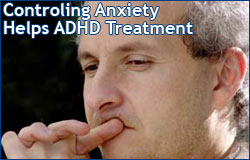Controling Anxiety Helps ADHD Treatment by Ron J. Swatzyna, Ph.D.
ADD and anxiety go hand in hand. There are a variety of reasons for this. ADD/ADHD can cause academic difficulties, social awkwar dness and other factors that can easily lead to anxiety. In addition ADD/ADHD manifests itself in the chronic hyperstimulation of the visual, auditory and tactile senses. Stimulation of the senses beyond a certain level activates the limbic system in the brain. This is the emergency response system that prepares us to fight, flee or freeze in the presence of danger. The greater the visual, auditory and tactile stimulation, the greater your body is prepared for an emergency response, even in the absence of a real emergency. If you have ever been on the roller coaster ride in an IMAX theater, you have experienced activation of the limbic system in the absence of any emergency. You know you are sitting on a bolted down seat, however you are hanging on as if you are on that ride. You experience every sensation without any gravitational changes. That is the limbic system at work! ADD/ADHD can overload the senses in the same way. One result is a perpetual low-level of anxiety unrelated to circumstances.
dness and other factors that can easily lead to anxiety. In addition ADD/ADHD manifests itself in the chronic hyperstimulation of the visual, auditory and tactile senses. Stimulation of the senses beyond a certain level activates the limbic system in the brain. This is the emergency response system that prepares us to fight, flee or freeze in the presence of danger. The greater the visual, auditory and tactile stimulation, the greater your body is prepared for an emergency response, even in the absence of a real emergency. If you have ever been on the roller coaster ride in an IMAX theater, you have experienced activation of the limbic system in the absence of any emergency. You know you are sitting on a bolted down seat, however you are hanging on as if you are on that ride. You experience every sensation without any gravitational changes. That is the limbic system at work! ADD/ADHD can overload the senses in the same way. One result is a perpetual low-level of anxiety unrelated to circumstances.
ADD/ADHD and anxiety are so closely linked, it can become difficult to separate them out. But it is important that they be separated because while the physical manifestations can be similar, the underlying causes are different. It can be difficult to treat ADD/ADHD while anxiety continues to feed the system. It is as though the anxiety seeks to inflame what ADD/ADHD treatment protocols seek to calm. In addition, it can be difficult to assess the progress of ADD/ADHD treatment if the symptoms don't abate. It can be the case, that the ADD/ADHD treatment is effective, but symptoms continue to manifest due to untreated anxiety. They physician is left wondering wither the ADD/ADHD is unresponsive, or if anxiety is masking treatment success. Untreated anxiety also lessens the effectiveness of ADD/ADHD medication and it increases negative side effects. One of the first steps in treating ADD/ADHD, therefore, is to treat the underlying anxiety. This, in essence, clears the playing field so the work of treating the ADD/ADHD has a greater chance of success.
Anxiety treatment does not necessarily require a drug regimen. Anxiety responds very well to biofeedback because the physical mechanism responsible for triggering brain changes associated with anxiety is respiration. In situations of genuine emergency (and situations of simulated emergency) the body prepares itself by taking rapid and shallow breaths. This type of breathing actually alters brain chemistry, triggering the survival response in the limbic system. In people with chronic anxiety, rapid shallow breathing becomes habitual. Most are not aware that they have incorrect breathing patterns. Breathing patterns can be returned to a more normal pattern with awareness and practice. Once breathing returns to normal, hyperactivation of the limbic system is reversed and the anxiety abates.
People with anxiety can teach themselves, via biofeedback, to override the false emergency messages coming into the brain. They can learn to turn off the stress fight-or-flight response when events are not life threatening. Biofeedback patients use computerized equipment that monitors physiological responses (such as breathing) and presents this information back to the individual using both audio and visual feedback. The patient uses this feedback to slowly gain control over their breathing and through this, their limbic system.
Neurofeedback therapy is another non-medication method to help a person learn how to modify their brainwave activity in order to gain control of anxiety.
Once the anxiety has been controlled, treatment of the underlying ADD/ADHD is usually much more effective.